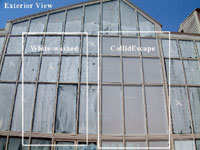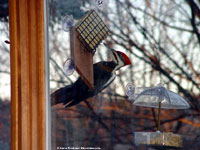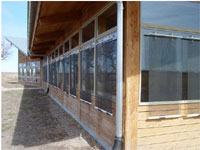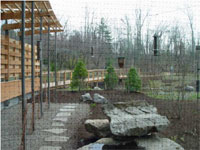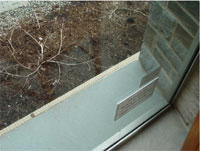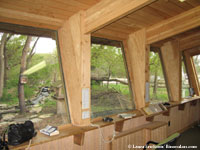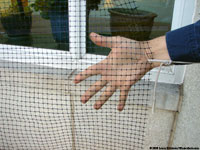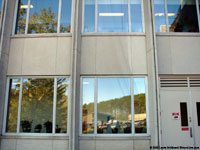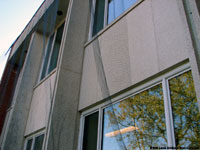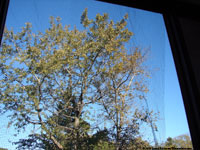|
Chapter 2: Around the House
#6: Make your windows safer for birds
More birds are killed from striking windows than any other single direct cause of death each year. Windows kill at least 100 million and as many as one billion birds in the United States annually, and the problem is growing as window sizes increase and houses grow larger. There are several ways we can make our own windows safer for birds. Things that can help birds avoid collisions or minimize the risk of being hurt include (listed roughly from most to least effective):
- Cover the glass on the outside with window screening at least 2-3 inches from the glass, taut enough to bounce birds off before they can hit the glass. The Bird Screen Company makes what looks like a wonderful product.
- Cover the glass with a one-way transparent film that permits people on the inside to see out, but makes the window appear opaque on the outside. You can find information about the best available products on the Fatal Light Awareness Program website. The best product currently available, called “CollidEscape,” is marketed by Large Format Digital. When you buy this product, part of the cost goes to support FLAP. Make sure these kinds of products are mounted on the OUTSIDE of the glass.
- Place vertical exterior tape strips on the glass, set not more than 10 cm apart, or mark the glass with permanent paint in the same way. (See Robin Stubb's comments below.)
- Install external shutters which are kept closed when you’re not in the room or taking advantage of the light or view.
- Install external sun shades or awnings on windows.
- On new construction or when putting in new windows, angle the glass downward, so it doesn’t reflect sky and trees.
- Use interior vertical blinds with the slats half open
- Soap the window on the outside.
- Put decals, sun catchers, mylar strips, or other objects on the window—better on the outer surface.
If none of these methods work, David Sedaris found a solution that worked for him.
Important: If you live or work in a tall building, turn off unneeded lights and keep your shades drawn at night, especially during migration.
Robin Stubbs has gone the extra mile to figure out a good solution for her windows: I tried the experiment of putting a white grid on the outside of glass in a screen house we have and some backyard house windows. The screen house has a continuous row of windows on all sides so it looked to the birds that they could "fly through" I think. So about 4 or 5 years ago I got ambitious and bought some white acrylic paint pens at a craft store. These are like "magic markers" that put out a line of acrylic paint. So using a large yardstick I applied a grid on the outside glass using 3 or 4 rows of lines depending on the size of the window, horizontally and vertically. I also put the grid on the glass or plastic door panes. It is my opinion that this did stop bird collisions totally.
It is also true I think that if you don't wash the windows it protects the birds as the dust builds up the outside of the window is no longer very reflective. That's why my windows are not very clean, I'm just protecting the birds :-) Acrylic paint will weather off eventually especially if you use ammonia glass cleaner. It stayed on there better than I ever imagined it would tho. Judging by the ability of even water-based house paint to stay on glass seemingly for all eternity when it gets on glass accidentally, that might be the kind of substance to try if one wanted to do a permanent grid job.
I didn't try to apply the grid on the bottom halves of the screen house windows because in that case it is a screen that is facing outside. It turns out that with the grid painted on the tops and the screens on the bottom that seemed to be enough to keep the birds from striking the windows. (These screens are from 1960, black metal and corroded. Newer screens might perhaps be more hazardous.) But if you put up storm windows that makes a window particulaly dangerous again in my experience, so storm windows would be a case to try applying something on the outside of the window (and easier to deal with because you don't have to stand on a ladder to apply a grid). I never had any luck with anything going on the inside of a window because it doesn't have any effect on the reflecting outside surface IMHO. It would be interesting to know how narrow a band can be and how widely spaced the lines could be and still work. I might try the circle idea per the article as I need to redo the windows but circles might be harder to do than lines. Maybe triangles :-) ?
For more information:
- Wisconsin Natural Resources article "Threshold of Pane" by William Mueller and Scott Diehl
- Audubon At Home: Minimizing Window Collisions
- Fatal Light Awareness Program information about safest window covering
- Wisconsin Humane Society "Be an Avian Advocate"
- US Fish and Wildlife Service: Clear the Way for Birds
- US Fish and Wildlife Service: The Danger of Plate Glass
- Wisconsin Bird Conservation Initiative: Collisions and Birds
- Daniel Klem’s important paper, “Bird-Window Collisions,” was published in the Wilson Bulletin, 101(4), 1989, pp. 606-620.
- Dr. Klem’s paper, “Collisions between Birds and Windows: Mortality and Prevention,” published in the Journal of Field Ornithology, 1990, 61(l):120-128.
- The Fatal Light Awareness Project has a great deal of information about bird mortality at lighted windows on their website.
- Rob Fergus, director of Audubon At Home, has lots of information about this and other issues on his own blog.
- Bird-protecting screening is manufactured by The Bird Screen Company .
- Bird Conservation Network: Windows and Birds
- Chicago Bird Collision Monitors
- Birds and Buildings: Creating a Safer Environment
- Daniel Klem, Jr., David C. Keck, Karl L. Marty, Amy J. Miller Ball, Elizabeth E. Niciu, and Corry T. Platt. “Effects of Window Angling, Feeder Placement, and Scavengers on Avian Mortality at Plate Glass.” The Wilson Bulletin, Vol. 116 No. 1, March 2004.
|


